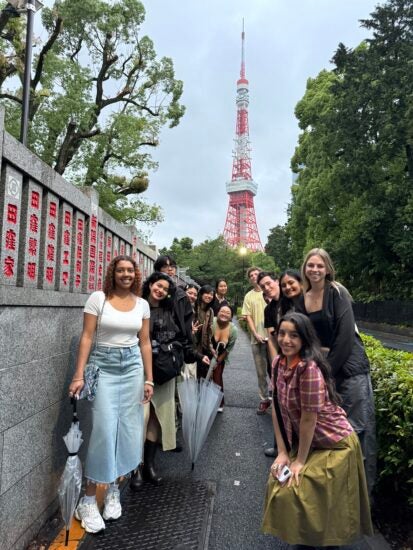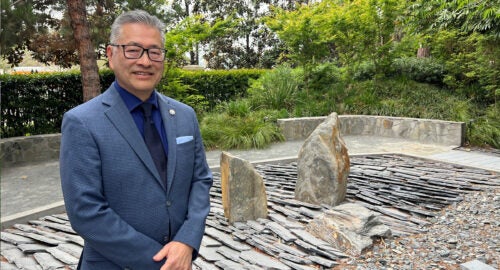
Global impact of Japanese design is focus of USC Dornsife course, supported by new endowment
“Keep your eyes, ears and especially your mouths open.”
This was alumnus Jon Kaji’s advice to the 16 USC undergraduates who were about to embark on a research excursion to Japan through the USC Dornsife College of Letters, Arts and Sciences’ Global East Asia Maymester program.
With the support of a new endowment from the Kaji family, students spent two weeks in Tokyo examining the role of contemporary Japanese design in social engagement and transformation to inform their own research projects.

Led by Miya Elise Desjardins, associate professor (teaching) of East Asian languages and cultures and art history, students immersed themselves in Japanese culture through site visits to the Asakura Museum of Sculpture; Tokyo Tower, an iconic Japanese landmark; 21_21 Design Sight, a contemporary design museum; Ikebana Sogetsu, a leading school of Japanese flower arranging; and even cafes and public spaces.
“We found design in everything,” said Amy Wu. “We saw many elements of design that exist to serve the greater good, but many of us gravitated towards more subtle forms of design that exist in our everyday lives.”
A themed entertainment major at the USC School of Cinematic Arts, Wu focused her research on how design could make the experience of waiting in line more interactive and enjoyable.
Other students’ projects included Lorenzo Hinojosa’s photography series using komorebi (light filtered through trees), John Miranda’s examination of street fashion, and Kira Sano’s research on how different cultures use community engagement campaigns to make a more sustainable society.
For Sano, who graduated for USC Dornsife in May with degrees in nongovernmental organizations and social change and environmental studies, the work was part homecoming and part career-building.
“As a third-generation Japanese who has never been able to go to Japan, it was a privilege to have the chance to reconnect with my culture while studying it academically in my field,” she said. “This course served as an incredible basis for understanding potential topics and to ground me in my career aspirations.”
Kaji endowment honors the past, inspires the future
A businessman and councilman for the City of Torrance, Calif., Kaji studied abroad in Japan for a year while a USC Dornsife undergraduate and credits the experience for his professional success. “It entirely changed my life and the trajectory of my career to include business and academic activities in Asia,” he says.
The L.A. native graduated from USC Dornsife in 1976 with Bachelor of Arts degrees in history and East Asian studies. He remains an active member of the USC Asian Pacific Alumni Association.
Kaji and his siblings established the Bruce and Frances Kaji Family Endowed East Asian Studies Center (EASC) Fund this spring as a tribute to their parents, Bruce and Frances Kaji. The couple’s history of activism includes a successful campaign to award posthumous degrees to Japanese American (Nisei) USC students whose studies were interrupted during World War II.
“Taking part in different cultures opens up our hearts and minds.”
A survivor of the Manzanar incarceration camp, Bruce Kaji leveraged his USC accounting degree to establish the firm that brought Toyota to the American market, ushering in a new era of Japanese investment that bolstered the Japanese American community. He went on to co-found the Japanese American National Museum and advocate for the preservation of L.A.’s Little Tokyo.
“For our family, education has always been a priority,” says Jon Kaji. “I feel that we have a responsibility to support others in our community to achieve their goals through higher education.”
His hope is that by enabling students to experience the world beyond their classrooms, the Kaji Family Endowment will help build a generation of leaders with a global perspective.
“Taking part in different cultures opens up our hearts and minds,” he says. “When students take on leadership positions in the future, they can make decisions based on these experiences and friendships.”
Kaji endowment fosters global connections
Kaji’s aspirations have already been realized: The spirit of cross-cultural exchange served as a cornerstone of the Global East Asia Maymester program.

Before leaving for Tokyo, students explored Los Angeles to study examples of the influence and adaptation of Japanese design, including Frank Lloyd Wright’s Hollyhock House and the Schindler House in Hollywood.
“Taking the time to appreciate the bits and pieces of Japanese culture throughout Los Angeles made me understand and appreciate all that Tokyo has to offer even more,” said Hinojosa, who graduated from USC in May.
What many students found most impactful, however, was connecting with host students at Tokyo’s Meiji University throughout their time in Japan.
“Our differences drove our desire to share more about ourselves in a completely unfiltered way that was devoid of judgment on both ends,” Hinojosa said. “I treasure the experience and hope these bonds will last a lifetime.”
The Bruce and Frances Kaji Family Endowed EASC Fund will stand as a lasting tribute to the family’s enduring commitment to education and community, Jon Kaji says.
Now a senior member of his family, he hopes to instill these values in his daughters, nieces and nephews. “Wherever you are, make sure to commit not just to your own growth but also to those around you,” he advises them.
“That is the continuing legacy of the Kaji family’s gift, not just to USC, but also to our greater community.”